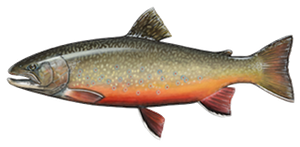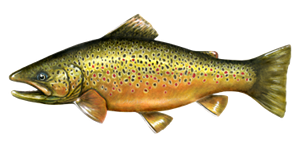Eastern Abandoned Mines Program
Goals
The Environmental Protection Agency cites abandoned mine drainage as the single largest threat to the Appalachian region. With more than 10,000 miles of streams polluted from abandoned mines in Pennsylvania and West Virginia alone, the pollution legacy of the coal mining industry is a stark reminder of what can happen when natural resources are developed without proper regulations in place. Brook trout, which used to thrive in these waters, no longer exist in many streams. Instead, the waters run bright orange, providing a glaring indication of what has happened. TU’s Eastern Abandoned Mine program is working to bring life back to these rivers and streams and to make them once again places where brook trout can thrive—and where anglers can again cast to wild brookies that once were found in these waters.
Tactics
TU’s work to address abandoned mine drainage began in 1998 in the lower Kettle Creek watershed in northcentral Pennsylvania. In 2004, TU expanded its Kettle Creek project into the West Branch Susquehanna River basin, which has since grown into TU’s Eastern Abandoned Mine Program. TU works with a variety of partners to address abandoned mine drainage by planning and implementing mine drainage remediation projects and providing technical expertise and organizational capacity building assistance to dozens of grassroots organizations and other entities. Restoring streams from the lingering impacts of abandoned coal mines will not happen overnight. It takes years, even decades, to go from assessing the complex chemistry of mine drainage to designing and constructing treatment projects to eventually seeing the brookies return to the once-dead streams. From educating youth and the general public about mine drainage pollution to conducting research to better understand and document biological recovery following remediation to advocating for the policies and funding needed to clean up abandoned mine drainage, TU staff are at the forefront of advancing the restoration of streams polluted from abandoned coal mines.
Victories
Grounded in science, with multiple doses of perseverance and patience, TU has had great success in working to reverse the ravages of decades-old abandoned mines in Pennsylvania. TU’s technical expertise and assistance is sought by both government and non-government organizations through its Abandoned Mine Drainage Technical Assistance Program. Over the past decade, TU has provided technical assistance to more than 50 groups on more than 140 abandoned mine drainage projects throughout Pennsylvania, which in turn has resulted in millions of dollars’ worth of remediation projects. TU’s work in the lower Kettle Creek watershed has led to the return of brook trout in the historically polluted Twomile Run and Middle Branch.
Although most of the mine drainage in Kettle Creek has been cleaned up, TU is not resting on its laurels. Partnering with watershed groups, county conservation districts, state agencies, and others, TU is working to complete additional abandoned mine drainage assessments and restoration projects in additional watersheds including: Anderson Creek, Chest Creek, Cooks Run, Morgan Run, Moshannon Creek, Muddy Run and Potts Run, to name a few. As TU and its many partners continue to address mine drainage pollution in other areas of the West Branch Susquehanna River watershed, water quality continues to improve and fishing opportunities are expanding as fish return to once polluted streams.
TU’s work on abandoned mine drainage cleanup has been acknowledged with multiple awards, including the President’s Fishery Conservation Award from the American Fisheries Society and several Pennsylvania Governor’s Awards for Environmental Excellence. TU is proud to have played an important role, along with many other partners, in the 2006 reauthorization of the federal Title IV Abandoned Mine Land Program and remains actively engaged with efforts to ensure this critical source of funding for mine drainage cleanup does not expire in 2021. Given its success to date, TU continues to expand its reach throughout Pennsylvania and beyond to clean up the many miles of damaged Appalachian mountain streams and rivers to make them places where fish can once again live and anglers can enjoy.
Staff Contact
Amy Wolfe, Director, Eastern Abandoned Mine Program and Pennsylvania Eastern Brook Trout Habitat Initiative awolfe@tu.org
Shawn Rummel, PhD, Eastern Abandoned Mine Program and Pennsylvania Eastern Brook Trout Habitat Initiative Field and Research Manager srummel@tu.org
Rachel Kester, Eastern Abandoned Mine Program Project Coordinator rkester@tu.org
Rebecca Holler, Eastern Abandoned Mine Program Education Coordinator rholler@tu.org
Kathleen Lavelle, Eastern Abandoned Mine Program and Pennsylvania Eastern Brook Trout Habitat Initiative Field Technician klavelle@tu.org
Author of this Page
Amy Wolfe


